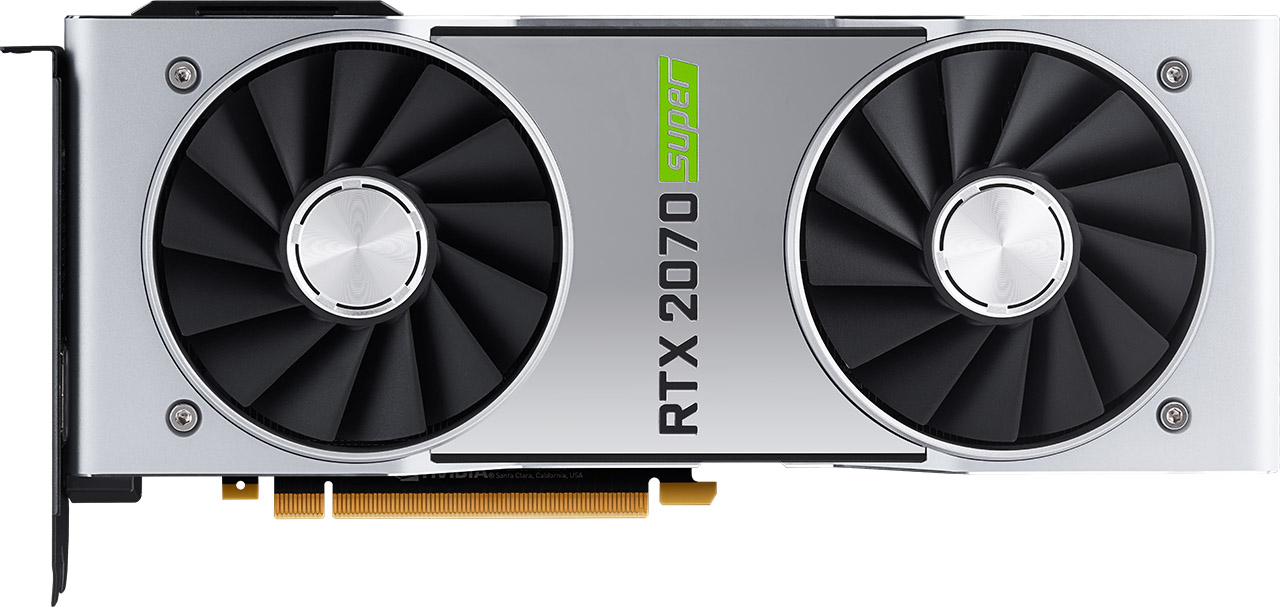GeForce RTX 2060 and 2070 Super Review: Nvidia Preemptively Strikes Navi
Why you can trust Tom's Hardware
Performance Results: 2560 x 1440
According to Nvidia, the sweet spot for its GeForce RTX 2060 and 2070 Super is 2560 x 1440. Dipping down to 1920 x 1080 doesn’t seem likely at such a steep price point, while pushing to 3840 x 2160 is asking a bit much from either one of these cards.
The company claims that GeForce RTX 2070 Super averages 16% faster than the vanilla 2070. Across our benchmark suite, the 2070 Super actually achieved 12.7 percent-higher frame rates on average. That’s not bad when you consider we’re comparing the $600 GeForce RTX 2070 Founders Edition to a $500 GeForce RTX 2070 Super. Nvidia struggled right out of the gate with Turing’s value story, particularly from the 2070 and 2080. But a little nudge from AMD’s upcoming Navi-based Radeons has the company re-thinking its positioning.
GeForce RTX 2060 Super enjoys a slightly larger advantage against its predecessor. In our tests, its average frame rate was 13.5 percent higher than the GeForce RTX 2060. You have to pay $50 more for that speed-up, though. GeForce RTX 2060 Super slots into Nvidia’s existing lineup to counter Radeon RX 5700.
Comparing the GeForce RTX 2070 Super to Radeon RX Vega 64 may be a little irrelevant at this point, given the impending Navi launch. You can still find Vega 64s selling for $400 though, so it’s worth mentioning that the 2070 Super averages 23.1 percent-higher frame rates. In other words, don’t bother with Vega-based cards at this point. Their replacements are right around the corner.
Battlefield V (DX12)
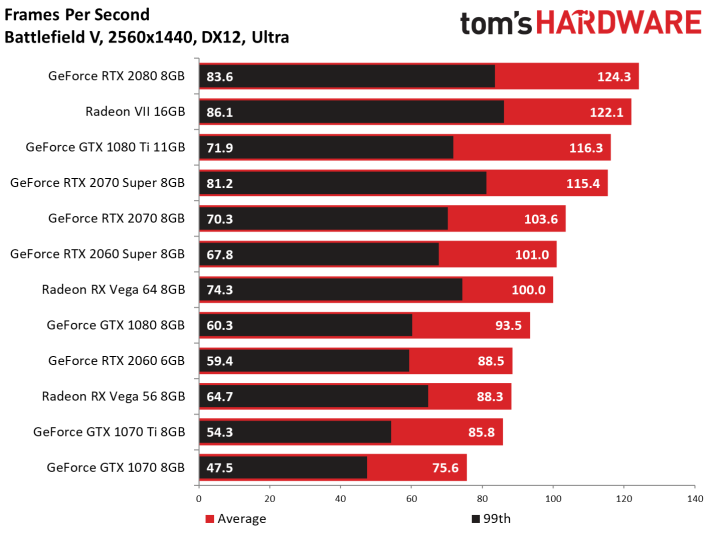
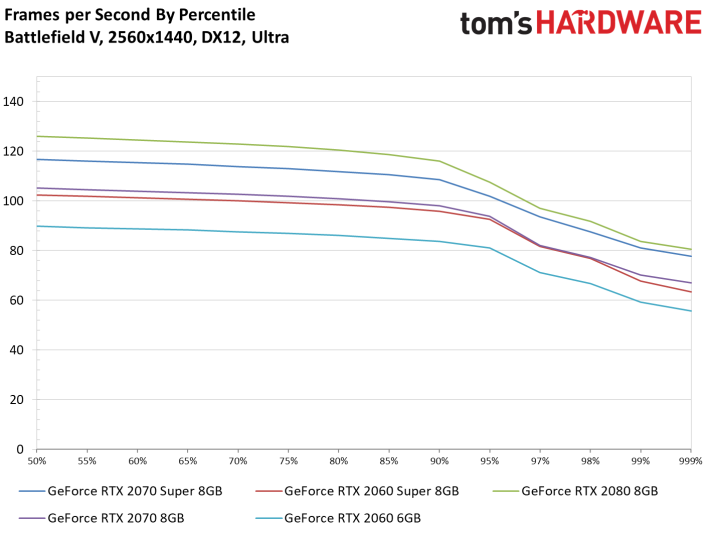

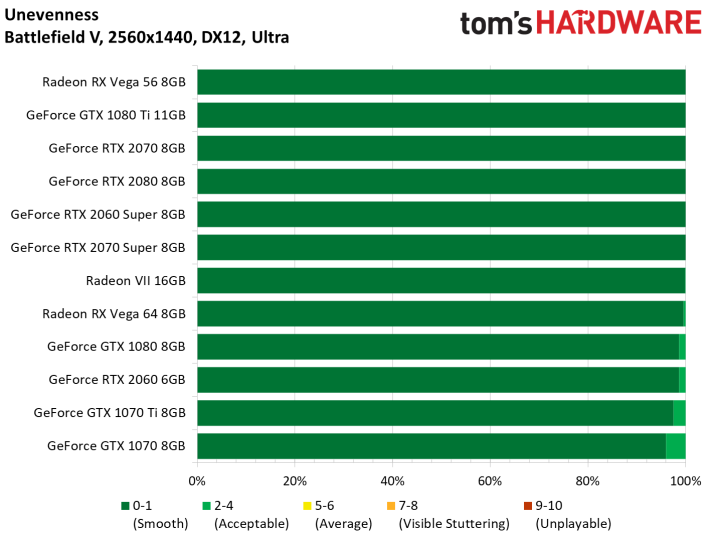
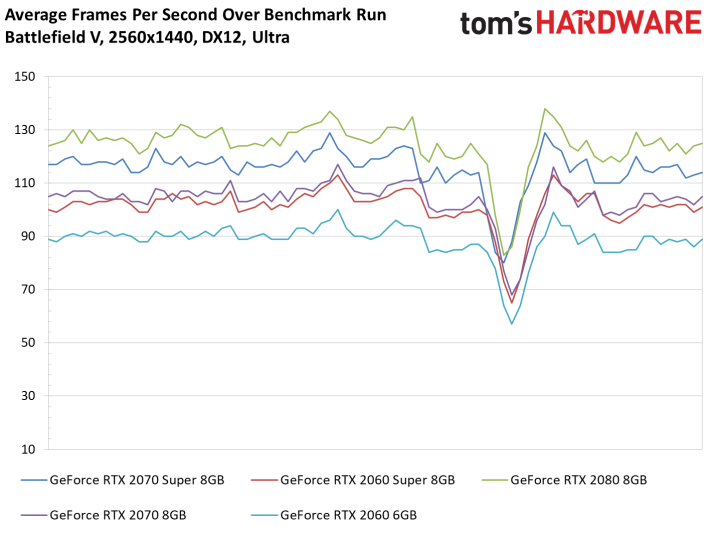
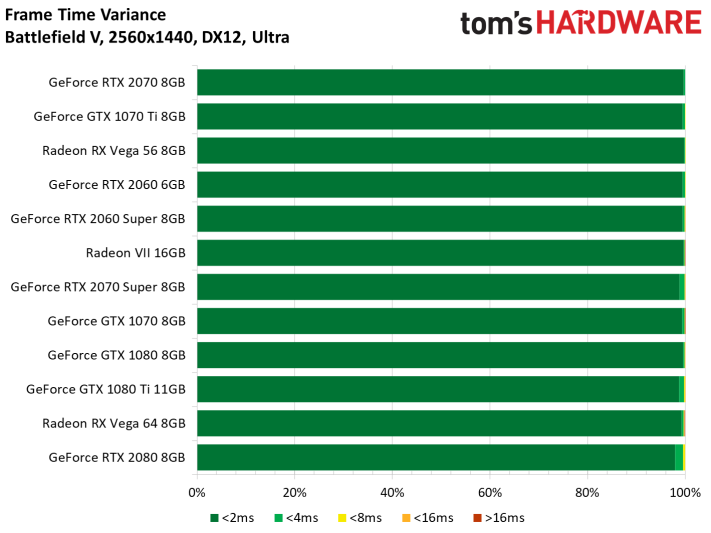

Destiny 2 (DX11)
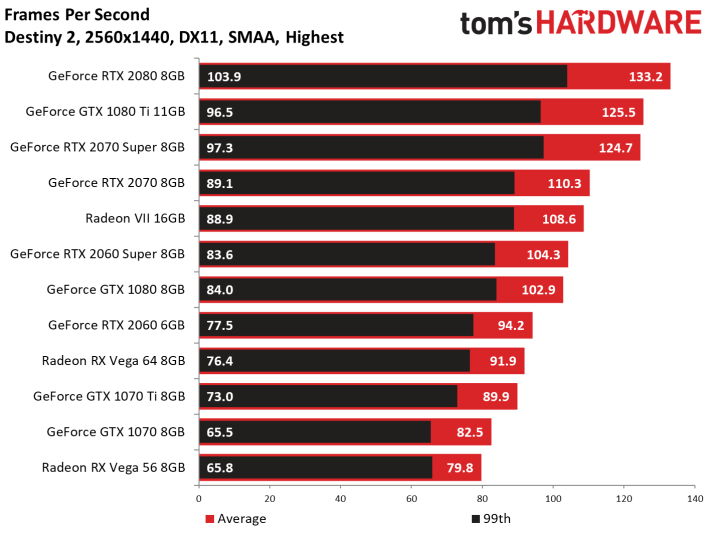
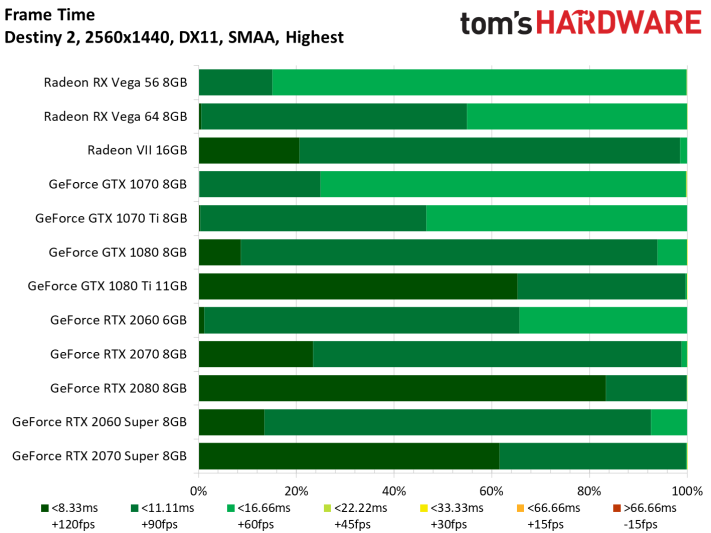
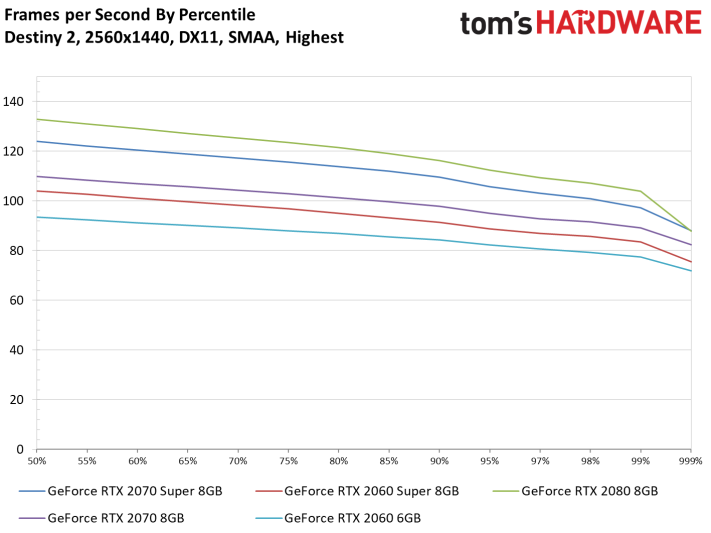

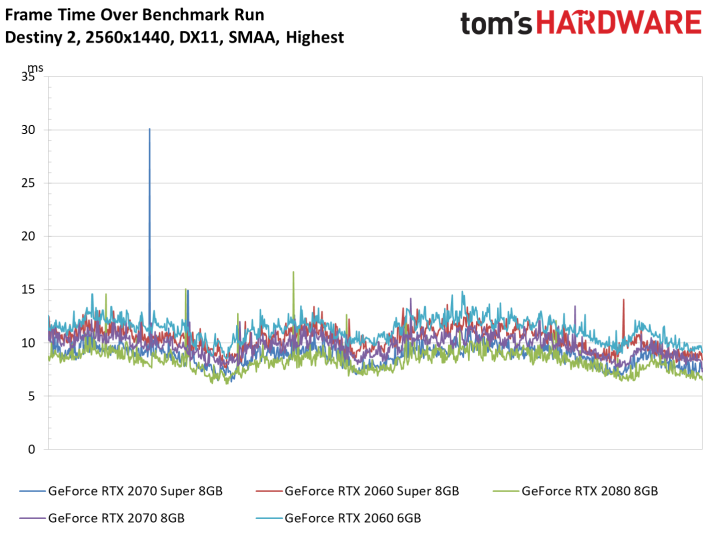

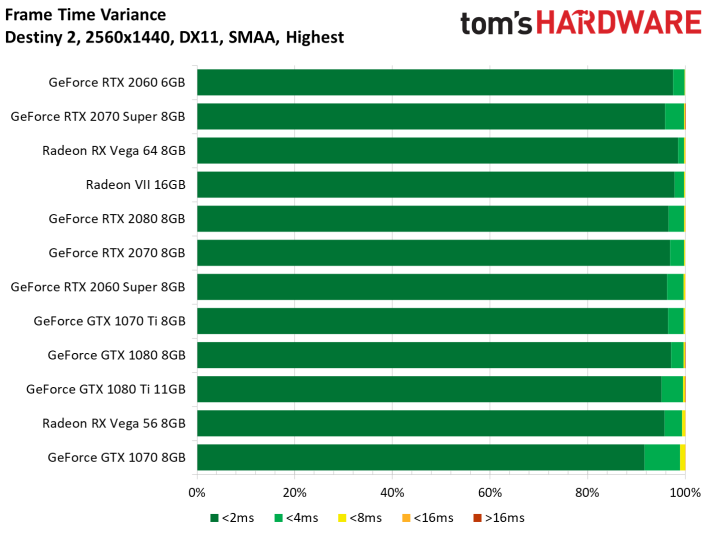
Far Cry 5 (DX11)




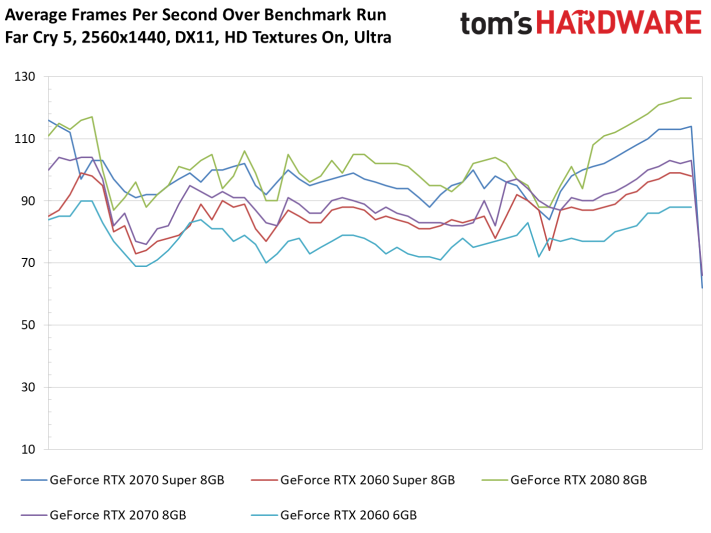

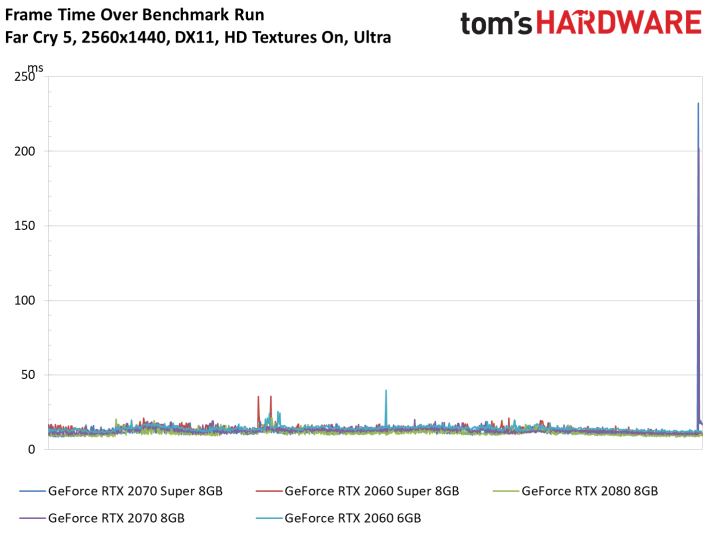
Final Fantasy XV (DX11)
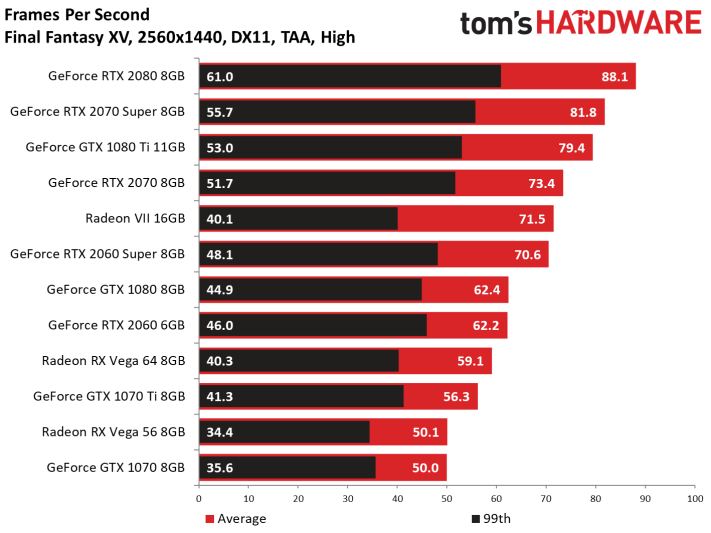
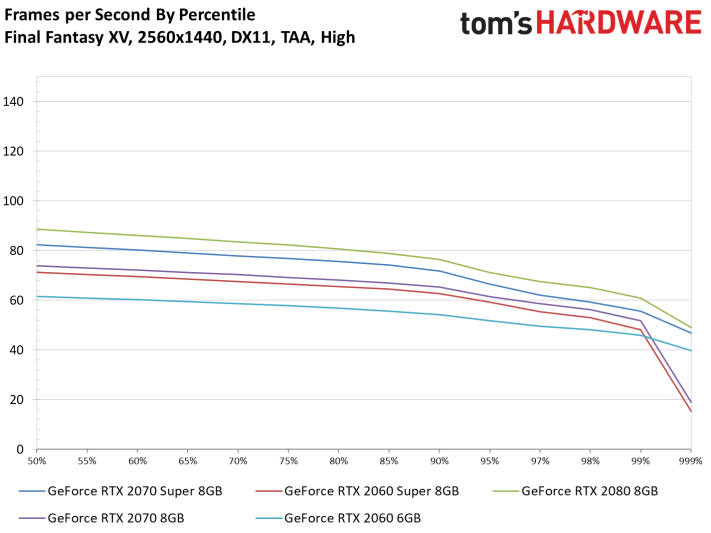
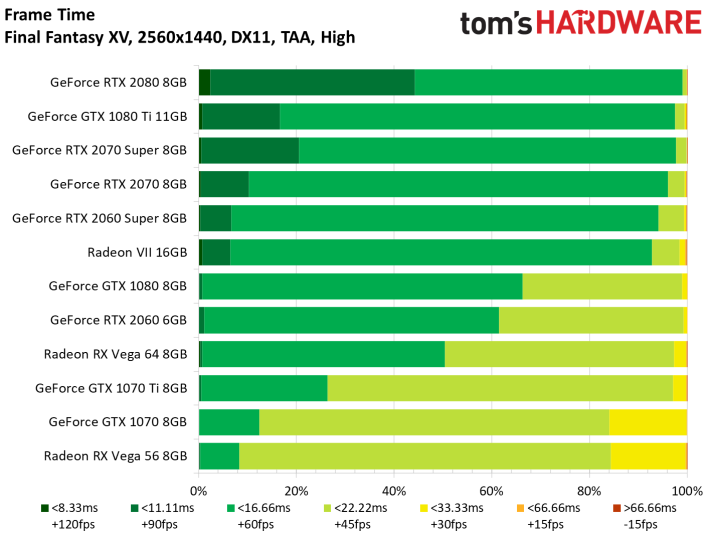
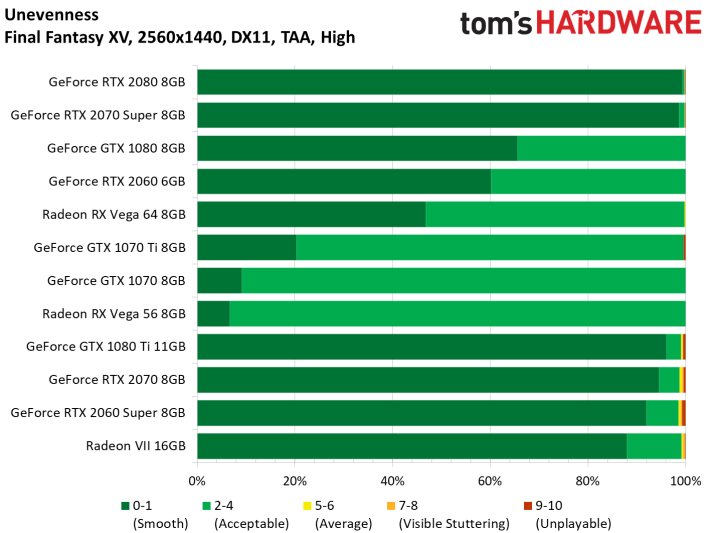
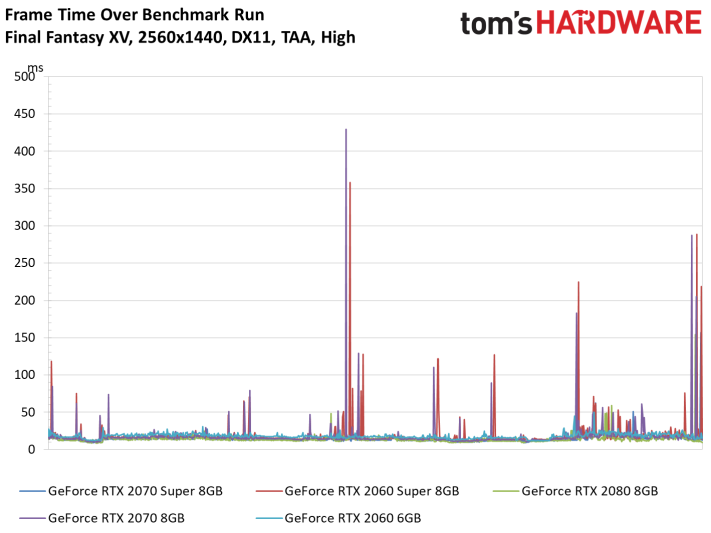

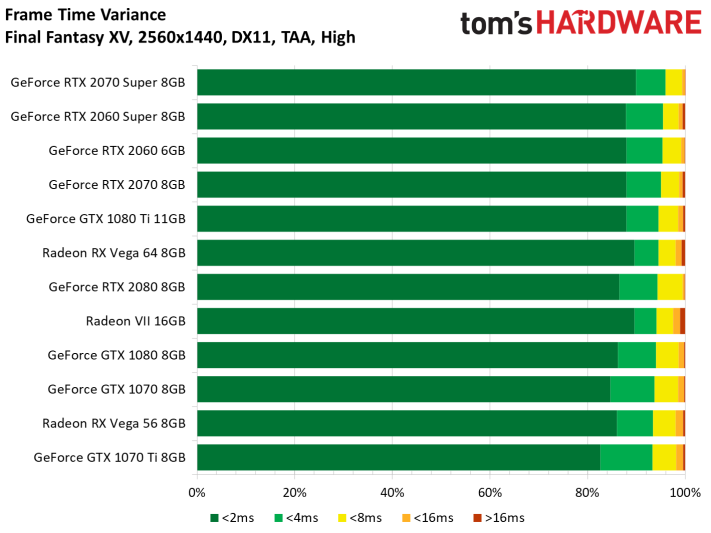
Forza Horizon 4 (DX12)
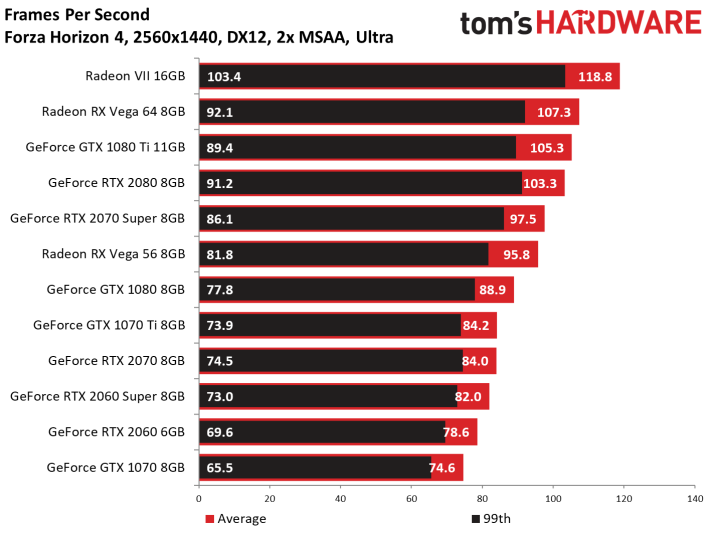
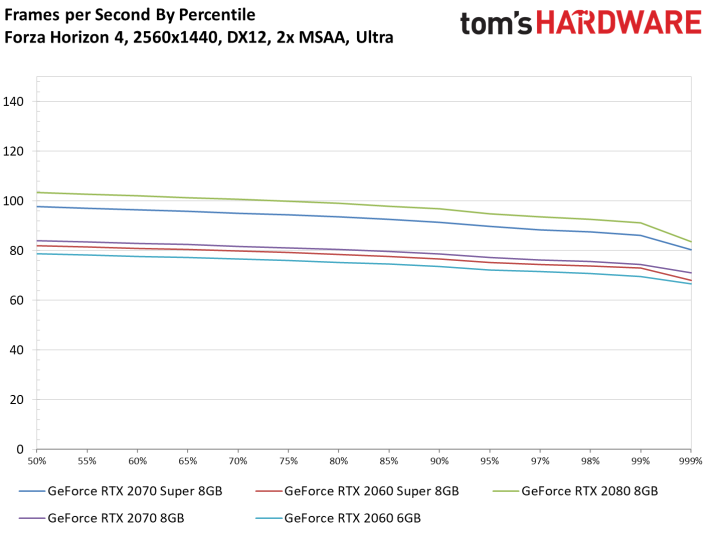


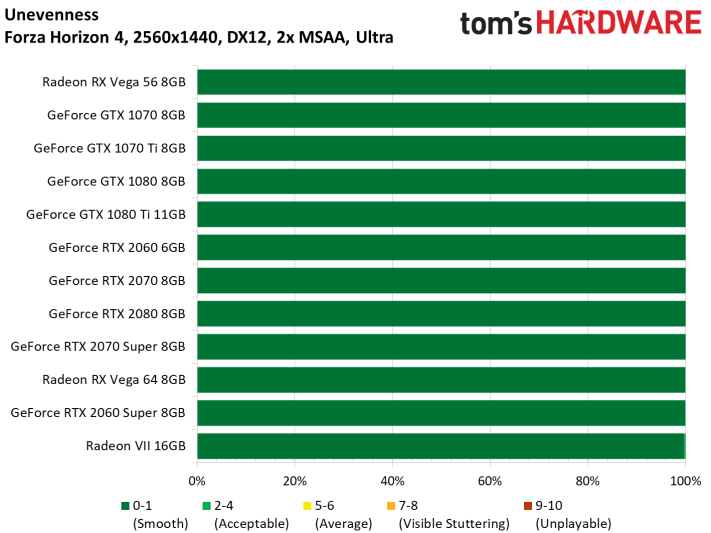
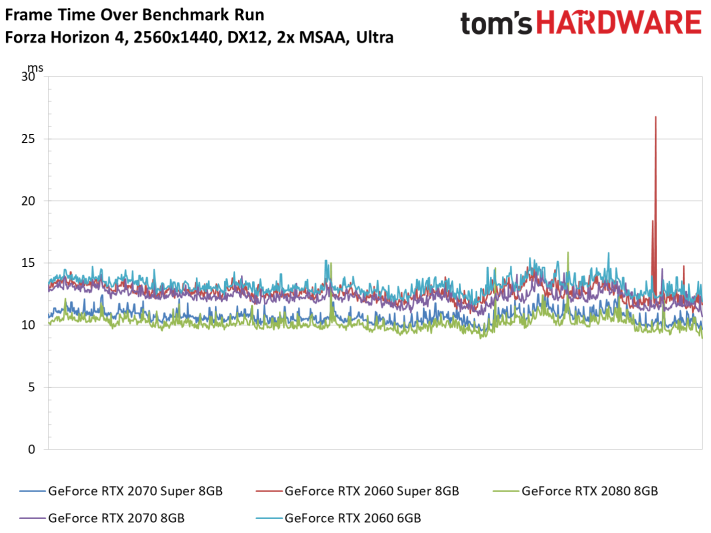
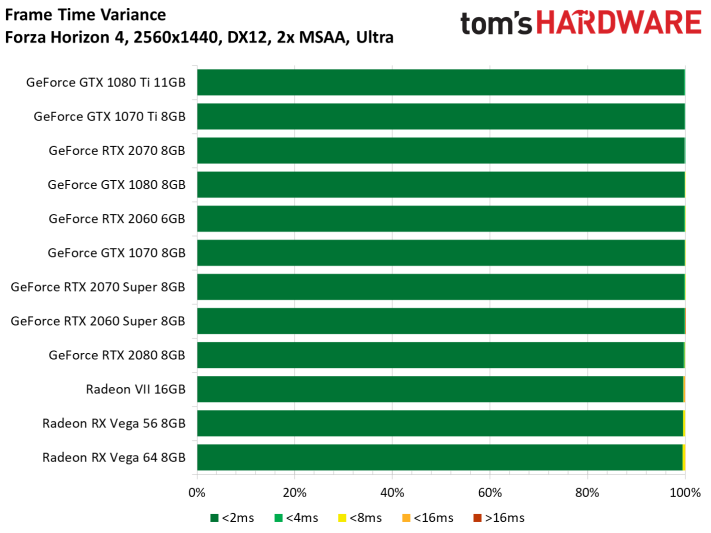
Grand Theft Auto V (DX11)

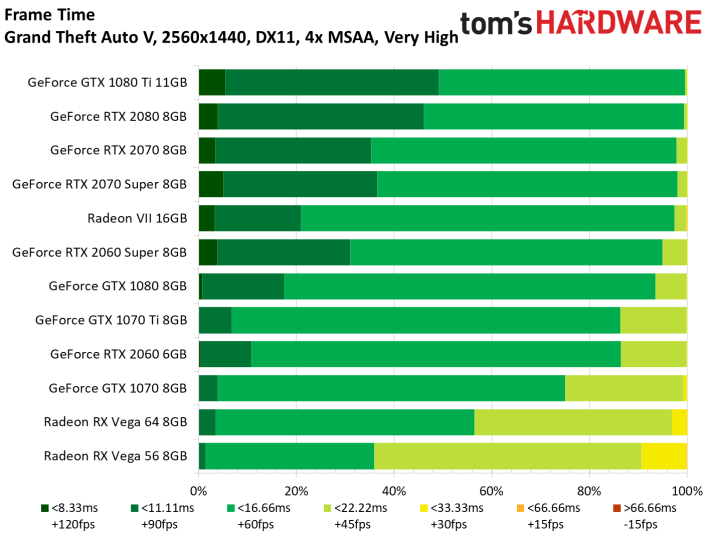

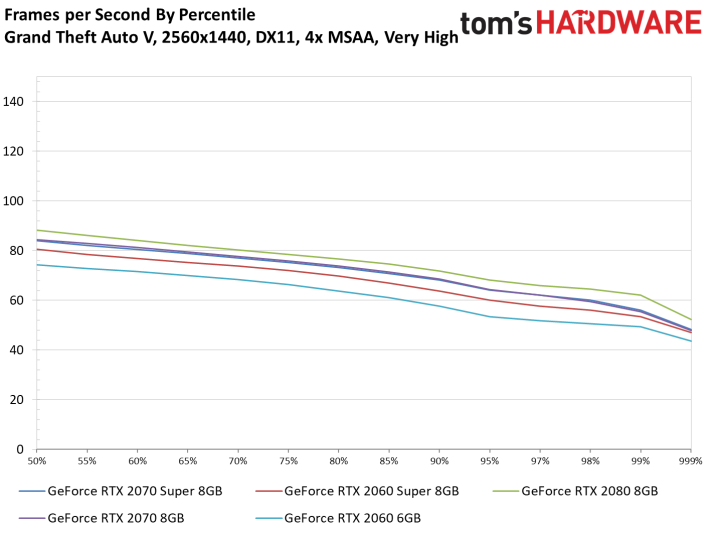

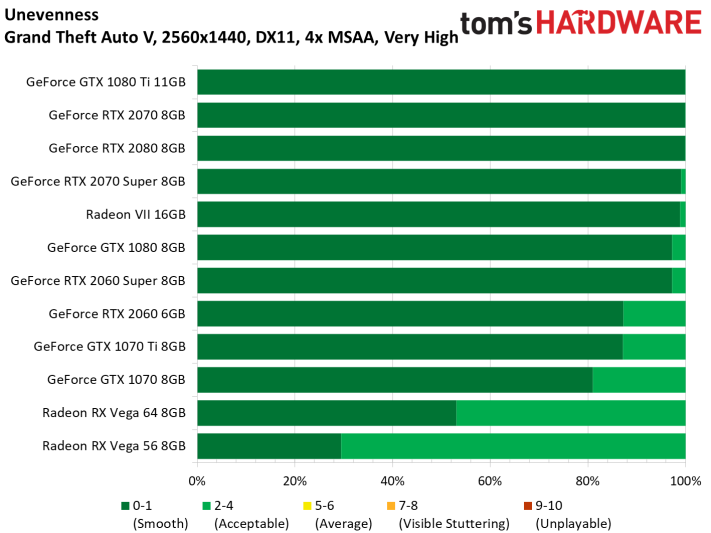
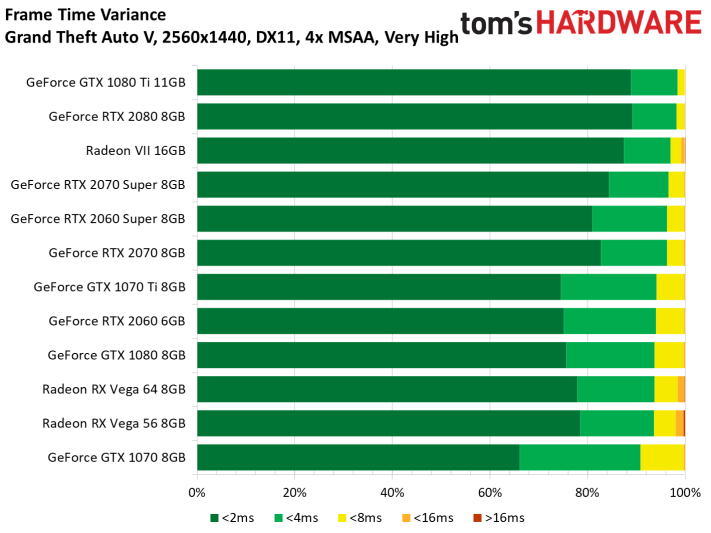
Metro: Exodus (DX12)

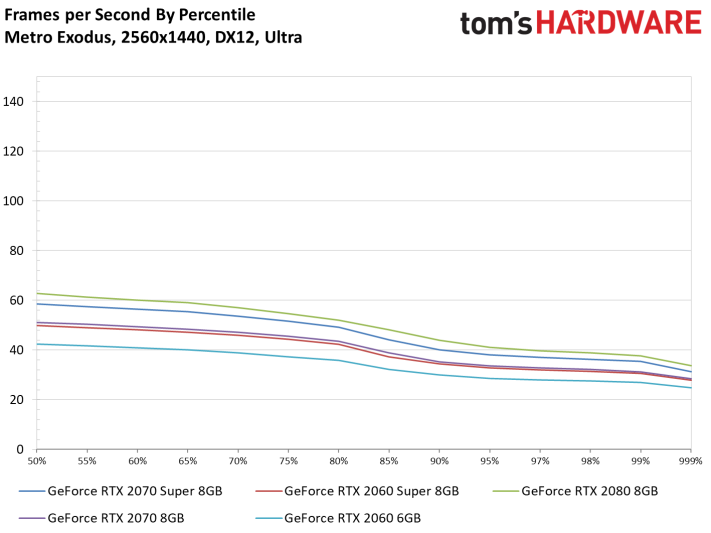

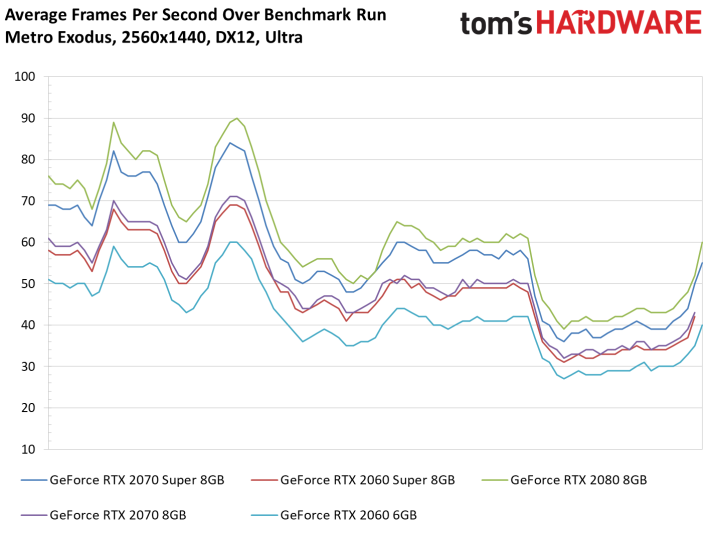

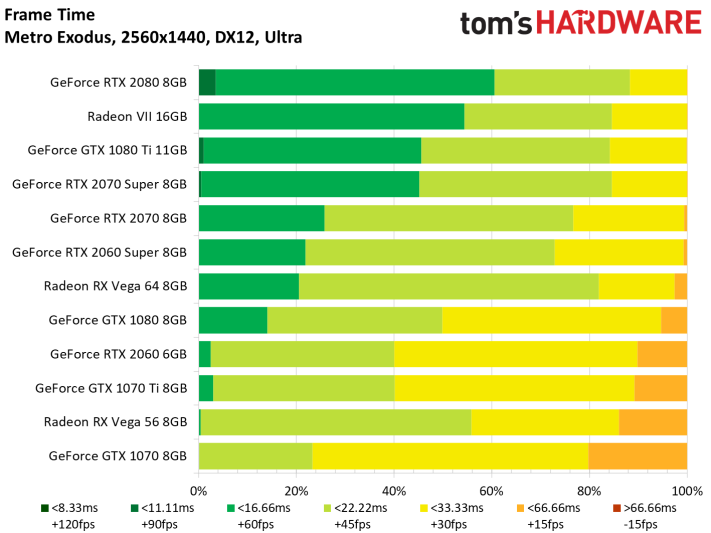
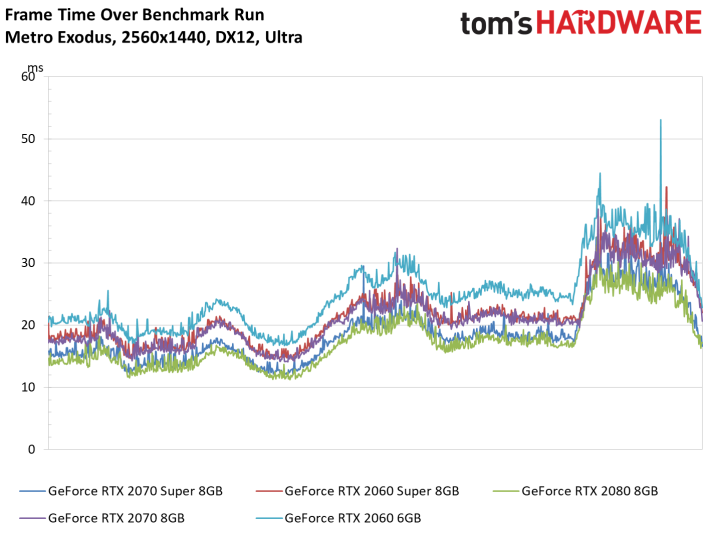
Shadow of the Tomb Raider (DX12)


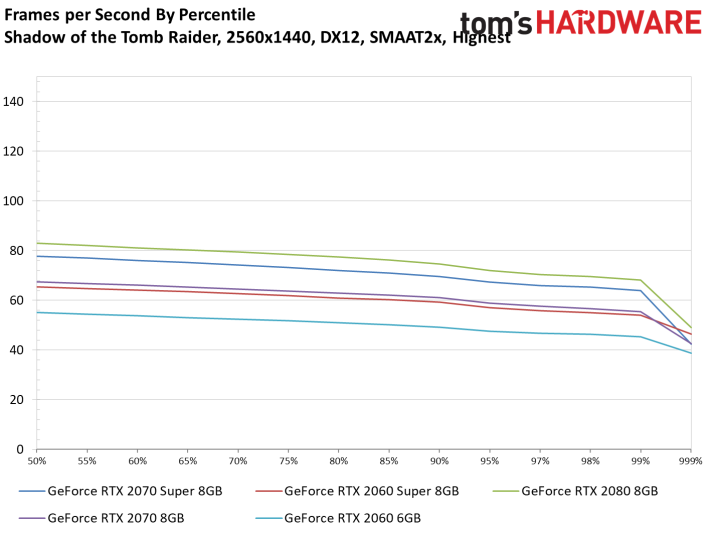
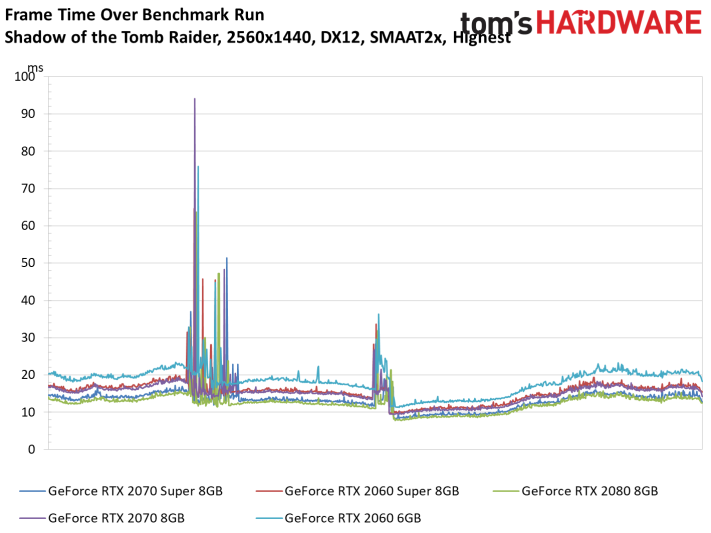
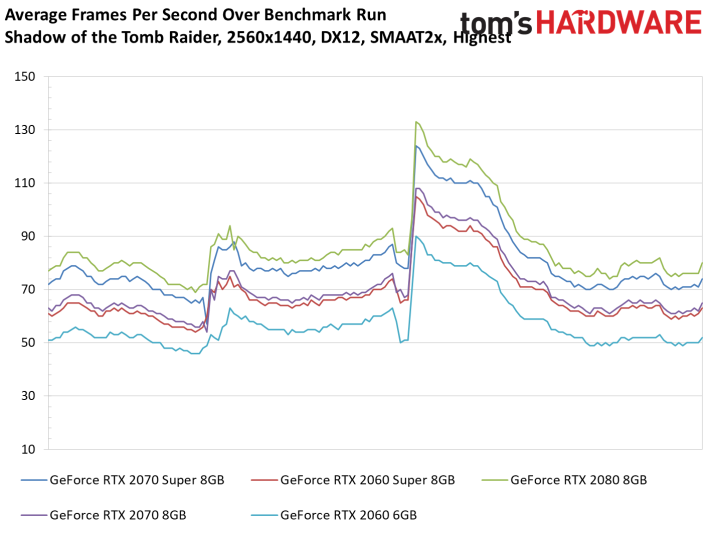


Strange Brigade (Vulkan)

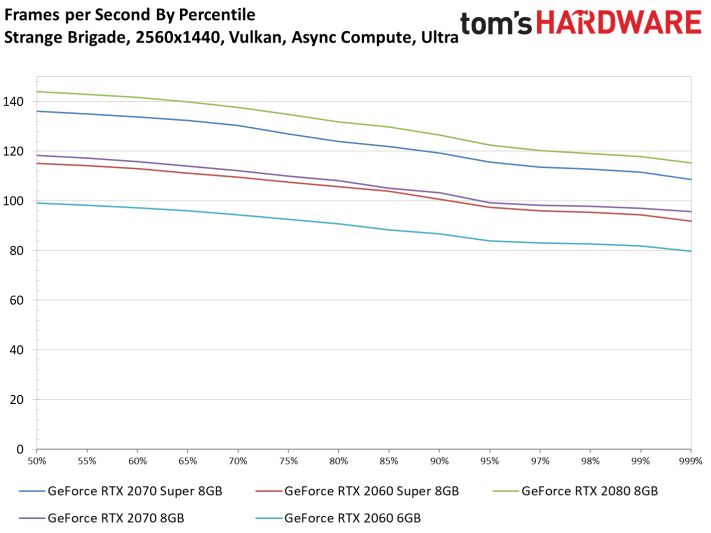
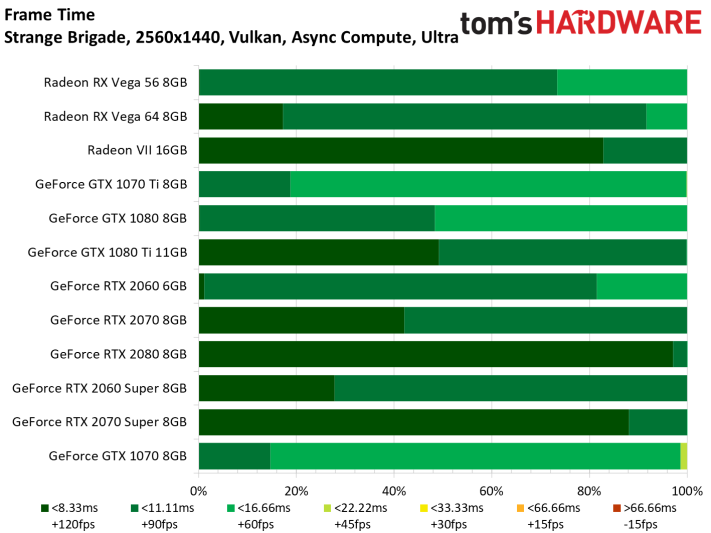
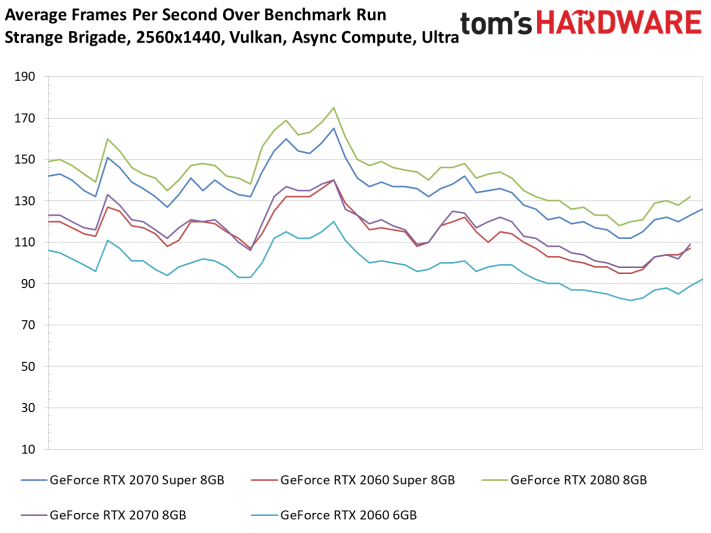
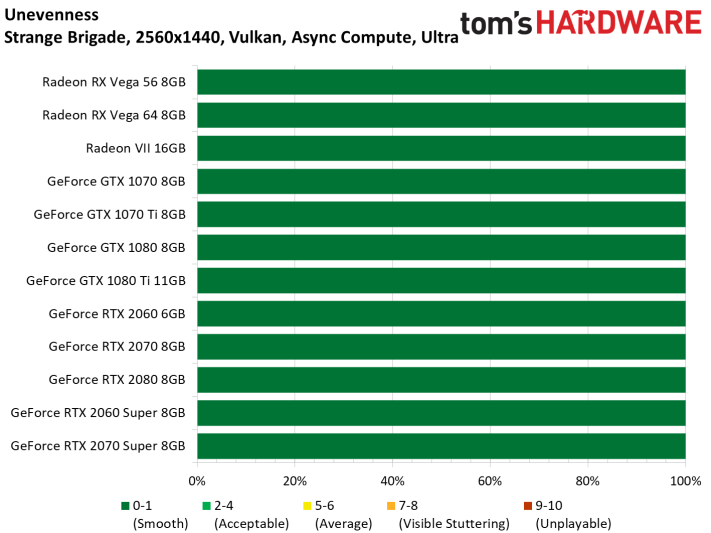

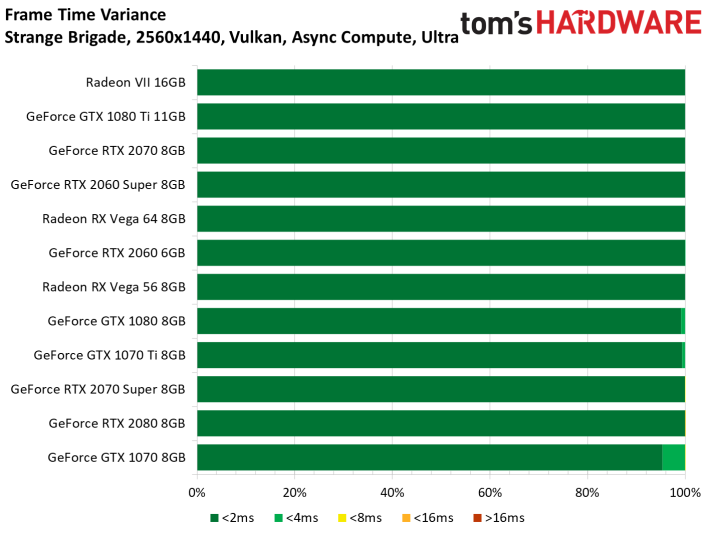
Tom Clancy’s The Division (DX12)
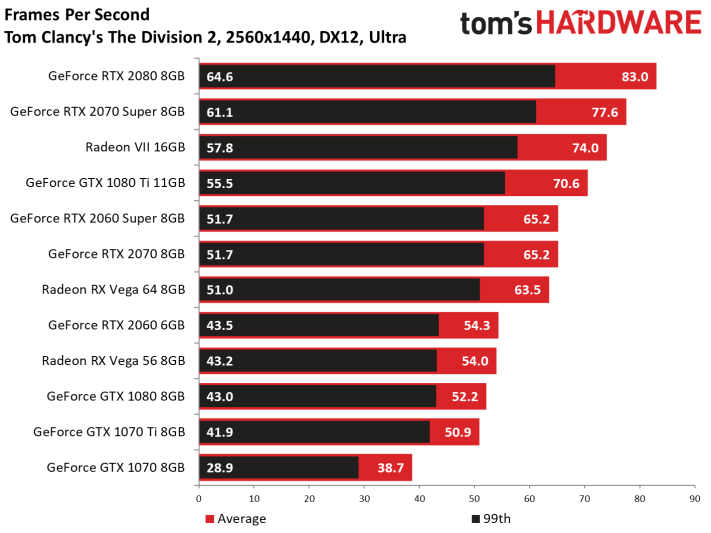
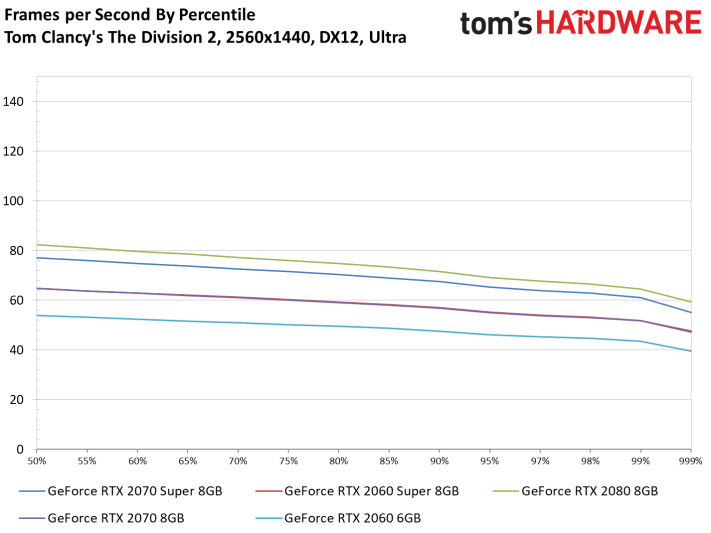

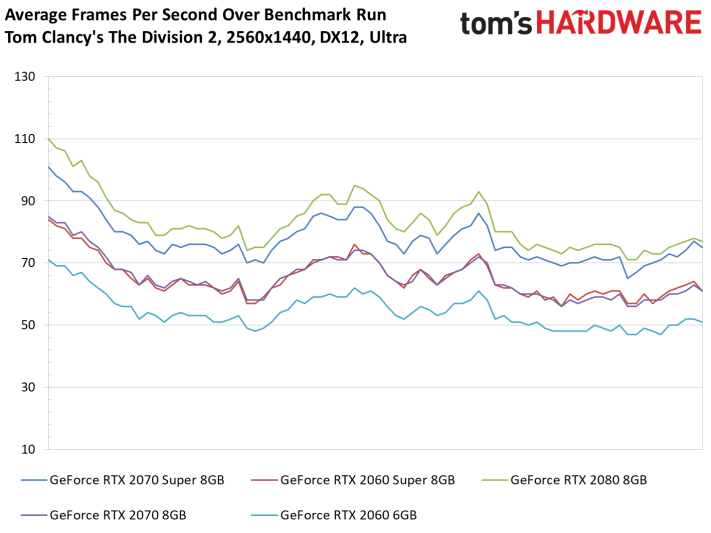

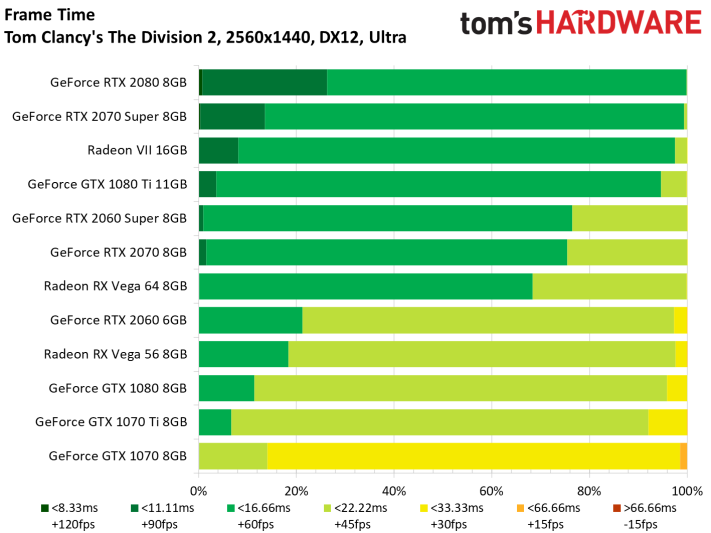
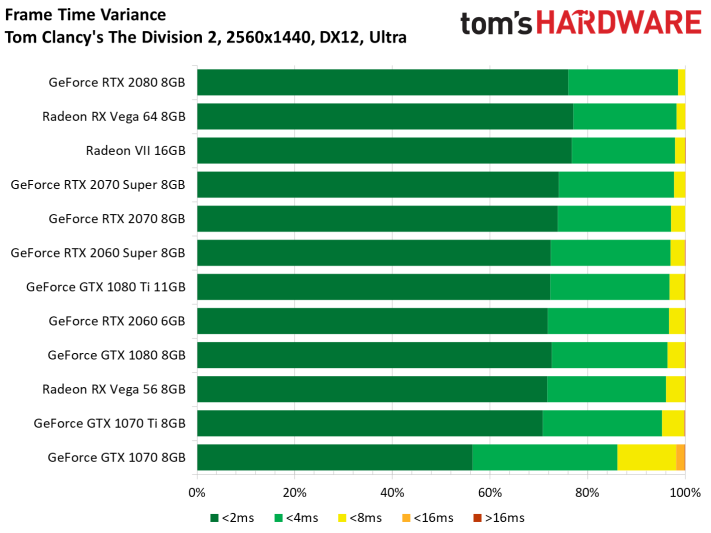
Tom Clancy’s Ghost Recon (DX11)

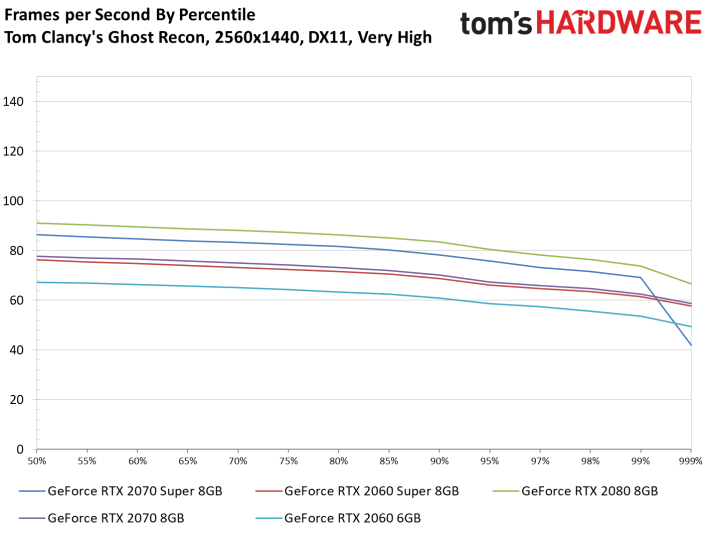
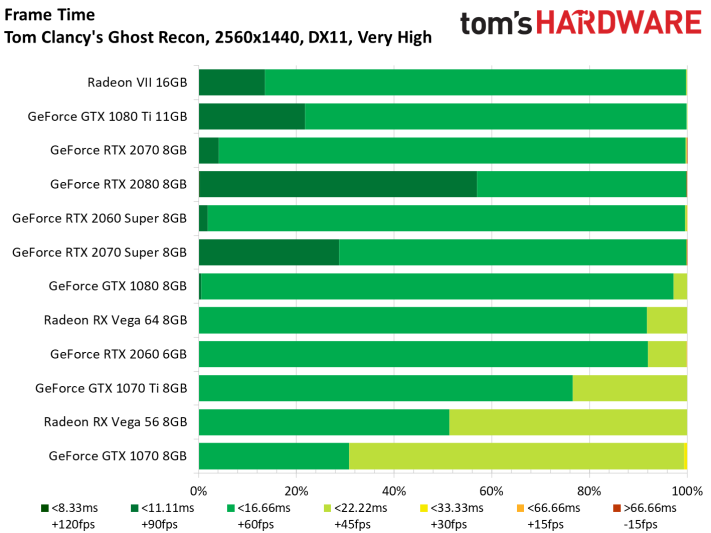
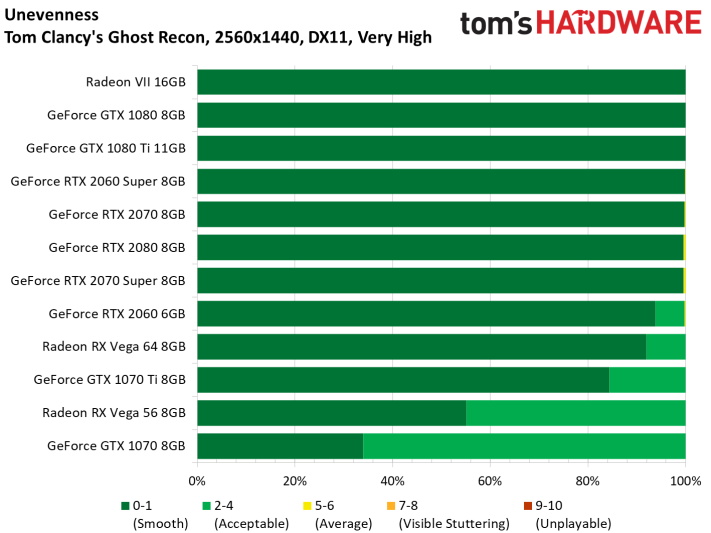


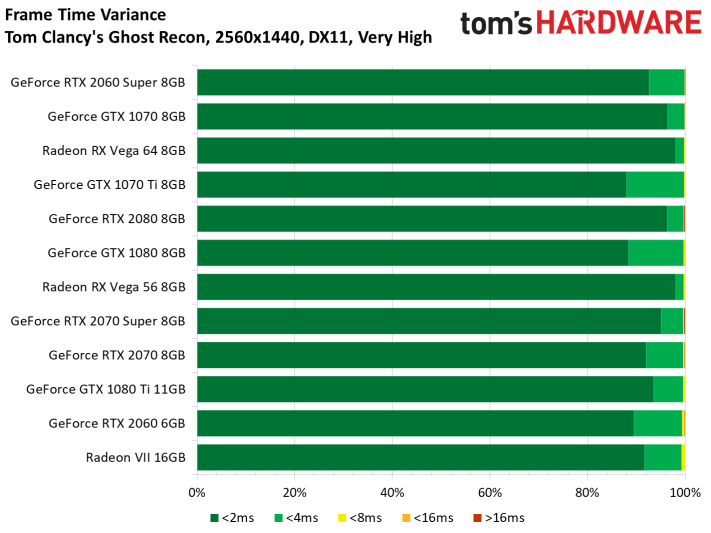
The Witcher 3 (DX11)




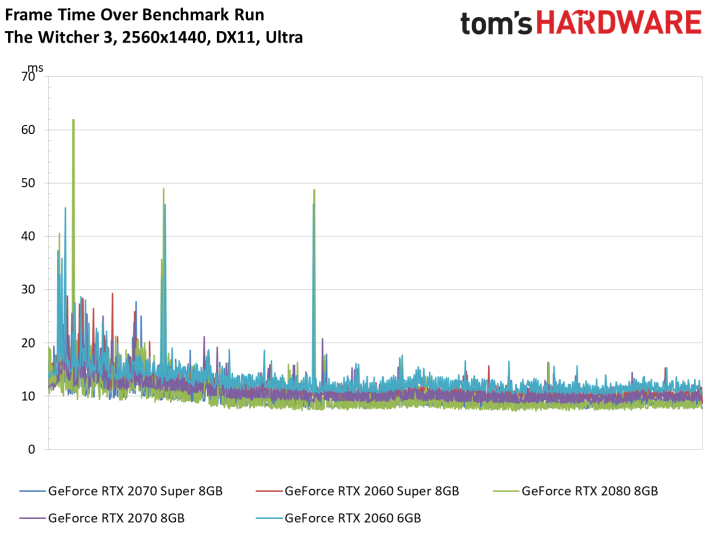
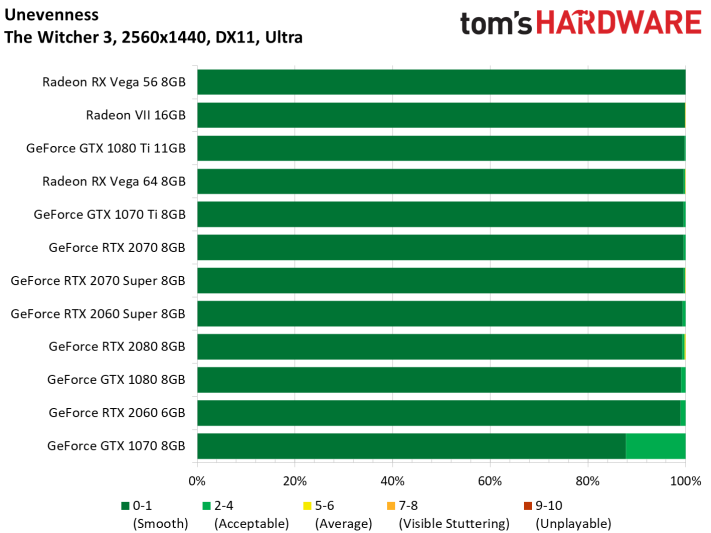
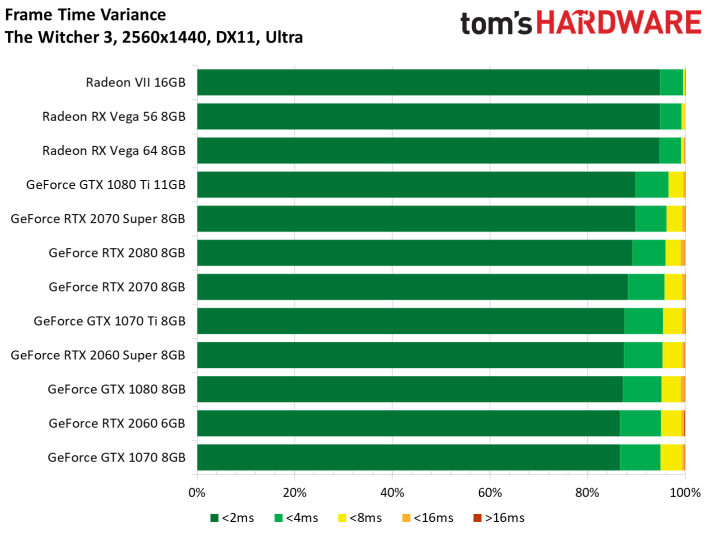
Wolfenstein II: The New Colossus (Vulkan)
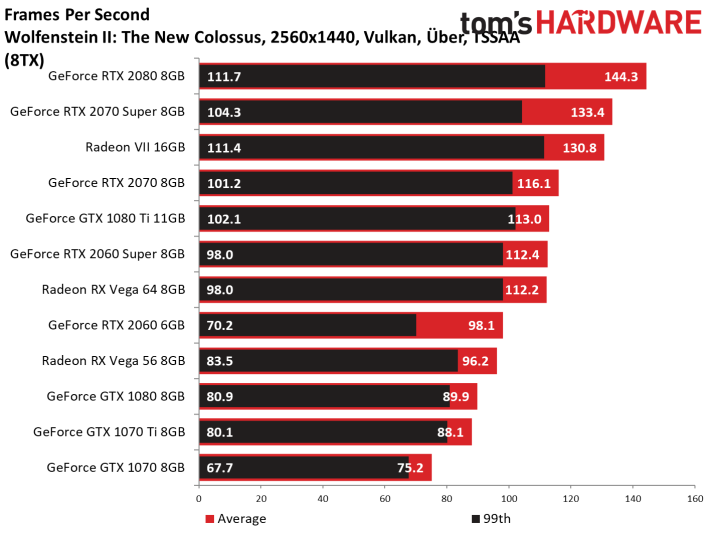
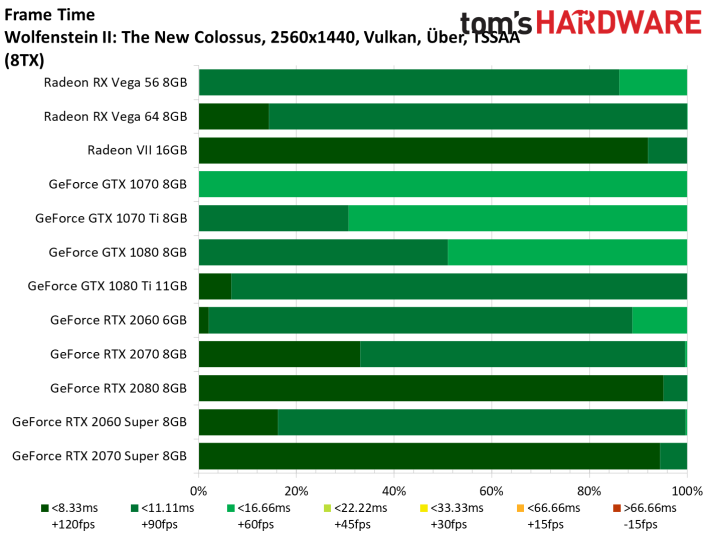



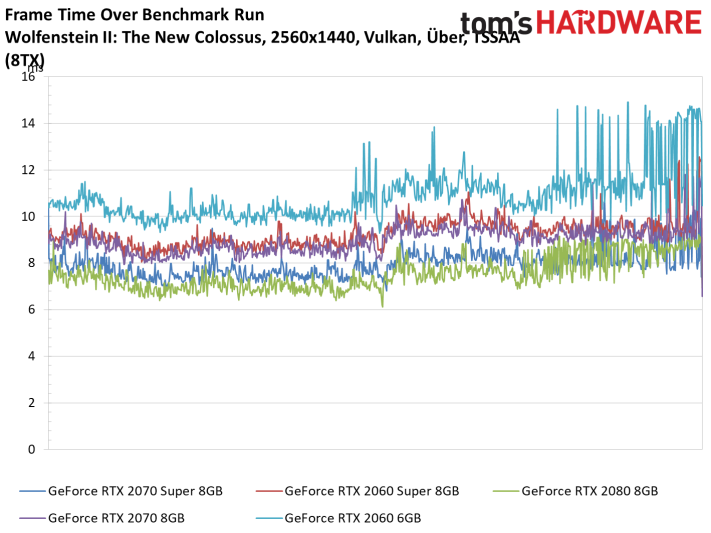
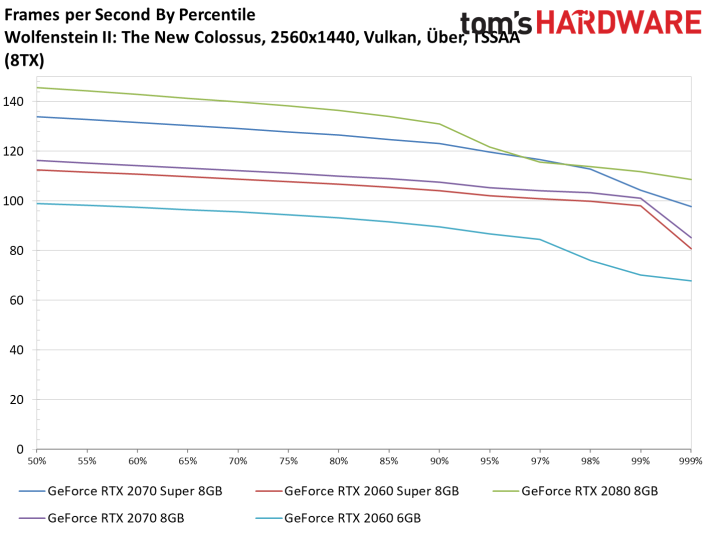
MORE: Best Graphics Cards
MORE: Desktop GPU Performance Hierarchy Table
MORE: All Graphics Content
Get Tom's Hardware's best news and in-depth reviews, straight to your inbox.
Current page: Performance Results: 2560 x 1440
Prev Page An Interlude For GeForce RTX 2080 Super and How We Tested Next Page Performance Results: 3840 x 2160-
jimmysmitty So short of a handful of games the RTX 2070 Super outperforms or matches the Radeon VII and comes in at $150 less ( more depending on which one you get). Thats a solid win.Reply
Guess now we wait for Navi to see if they have anything decent to counter. -
Giroro I think if Nvidia could have dropped the price of the RTX 2060, they probably would have done that instead of releasing the RTX 2060 super for $50 more.Reply
Unfortunately, all those leftover RT and AI cores make for a giant and expensive to manufacture die. I'm not sure if we'll ever see an RTX card for under $350, but AMD could probably drop the 5700 down well below that if they were really pressed.
As for the value proposition of Ray Tracing itself... That's still really dubious. The overall number of upcoming RTX games is still lower than the overall number of RTX -laptops- on the market. I don't know about anyone else, but I'm not exactly lining up to spend $400+ for somewhat prettier graphics in the 2-3 games I find interesting. I have a feeling that most of the early adopters banking on the promise of future support probably bought an RTX card months ago.
So, cool on Nvidia for flexing their muscles and remaining the strongest, I just don't see it winning over that many new customers. -
fraserlawrence Thank goodness we are starting to see value swing back towards the gamer and away from the cryptomining bubble. I may finally upgrade my gtx 970 ($339 in late 2014) to take advantage of 1440p gaming. Will an Intel Core i5-4690K temporarily work OK with an RTX 2060 Super until I upgrade the rest of my rig? Mostly playing AAA single player games like AC Odyssey, Far Cry 5, Sekiro and Shadow of Tomb Raider. Thank you Tom's Hardware for all the help getting started and balancing a gaming PC build with excellent reviews and best value discussions.Reply -
cryoburner ReplyInserted right between the $350 GeForce RTX 2060 and $500 RTX 2070 Super, we can’t imagine that anyone actually asked for a $400 GeForce RTX 2060 Super.
A better way to look at it is that the 2060 Super is offering near-2070 performance for $100 less. It performs within a few percent or so of the 2070, so this is almost like Nvidia lopping $100 off the 2070's MSRP. You do lose around 5% of the graphics cores, but retain the full 8GB of VRAM and memory bandwidth of that card. This is more like the kind of pricing we should have seen from the 20-series to begin with, and I think the cards would have been a lot better received if that had been the case.
Back when there weren’t any ray tracing- or DLSS-enabled games to show off the Turing architecture’s most prominent features, those were unforgiving comparisons.
DLSS has proven to be more or less useless, being little more than a mediocre upscaling method in practice. It might not be bad if it looked or performed better than all other forms of upscaling, but it doesn't. A number of games use other upscaling methods that are not only better, but also don't require any special hardware, allowing them to run on any card while offering better performance than DLSS for a given level of image quality. So, as far as that feature is concerned, the comparisons are even worse now than they were when people didn't know what DLSS had to offer. It's gone from being a potentially useful feature to being a non-feature.
And there are still only a few games released so far that support raytraced lighting effects, and enabling them still kills performance at the resolutions most people are likely buying these cards for. Raytraced effects have the potential to improve visuals, but the current cards don't have nearly enough RT cores to run them well. I suppose the Super lineup helps a bit by making slightly more RT cores available at a given price point, but it's not nearly enough to prevent the performance hit from being substantial relative to the minor improvements to visuals. Perhaps next year's cards will make hybrid raytracing more viable.
Still, I do agree that if two cards otherwise offer similar performance at a given price level, hardware raytracing support is definitely something that can help differentiate one card from another. Enabling those effects might cause a big hit to performance, but at least the option is there. For that reason, I think the 5700 and 5700 XT may have a hard time justifying their launch prices compared to the Super cards, unless they perform significantly better than expected. The pricing seemed a bit underwhelming from the start, and even without the Super cards available, I felt each of those Navi cards should have been priced about $50 lower. The initial 20-series pricing was underwhelming from the start, and AMD didn't seem to be pushing value much beyond that, despite these cards launching the better part of a year later. AMD had the opportunity to build some hype for their new generation of cards through competitive pricing, but appear to have followed Nvidia's lead in price-gouging their new cards, despite not bringing anything really new to the table. Better pricing from the start could have prevented Nvidia from raining on their parade with the Super cards.
And on that note, the Radeon VII is the real loser compared to the Super lineup. Its value was already a bit questionable for anyone not utilizing its 16GB of VRAM for certain professional applications, since the RTX 2080 was already offering more gaming performance and dedicated RT hardware with lower power demands for about the same price, but now the 2070 Super will be offering similar performance along with RT hardware for almost $200 less. That makes the VII a no-go for just about anyone interested in it for gaming, and due to its large amount of expensive HBM2 VRAM, I doubt AMD could drop its price by $200 to compete. -
cangelini Replycryoburner said:A better way to look at it is that the 2060 Super is offering near-2070 performance for $100 less. It performs within a few percent or so of the 2070, so this is almost like Nvidia lopping $100 off the 2070's MSRP. You do lose around 5% of the graphics cores, but retain the full 8GB of VRAM and memory bandwidth of that card. This is more like the kind of pricing we should have seen from the 20-series to begin with, and I think the cards would have been a lot better received if that had been the case.
That's another way to look at it, yes. I see it as where 2070 should have been at launch, agreed! -
bit_user Why don't the charts show the specs of the old vs. new cards, like pretty much every other site???Reply -
bit_user Reply
By comparison with Turing and especially these Supers, the efficiency of the Pascal cards seems almost exquisite.chill1221 said:Glad to see my 11GB 1080 TI still hanging tough!
I hope their 7 nm cards bring a return to the Wattage of that era. -
bit_user Reply
I think the problem is they tried to do too much with it. The more sophisticated the model, the longer inferencing takes and the less time is left for conventional rendering. So, they could either go with a sophisticated model designed to enhance low-quality AA, or a simple model that's basically just an improved scaler and able to be paired with decent AA. Because the former is easier to sell, they went with that. However, maybe they should've just gone with the latter.cryoburner said:DLSS has proven to be more or less useless, being little more than a mediocre upscaling method in practice. It might not be bad if it looked or performed better than all other forms of upscaling, but it doesn't.
Anyway, it's essentially a software feature (although it depends on the tensor cores). So, there's always a chance they'll reverse course.
First, it's much easier to lower prices than to raise them. So, AMD could quickly come down from its launch pricing.cryoburner said:AMD had the opportunity to build some hype for their new generation of cards through competitive pricing, but appear to have followed Nvidia's lead in price-gouging their new cards, despite not bringing anything really new to the table. Better pricing from the start could have prevented Nvidia from raining on their parade with the Super cards.
Second, I see the Super cards as pretty much inevitable, no matter what AMD did with pricing. The only real variable was whether and how Nvidia adjusted their pricing. The big question is whose price floor is higher. If it does come to a price war, how much can they each drop?
I've always seen the RTX features as very much about creating enough differentiation to justify higher pricing. However, they're far from the must-haves Nvidia surely hoped. As such, I think they're not yet sufficient to keep the RTX cards out of a price war. Maybe in the next gen, but not now.
It's true and a fair point, but you surely know it wasn't designed as a gaming card. The way to think of it is as a Titan - something of a specialty product that's soon to be surpassed by the next generation. Like the Kepler Titan and the Titan V, it's a professional GPU that they let gamers and prosumers have at a more accessible price point.cryoburner said:the Radeon VII is the real loser compared to the Super lineup. -
alextheblue Reply
You meant to say "breathtaking", of course.cangelini said:...wouldn’t want to play the game at any detail preset that has Keanu look like less than the beautiful man he is.
Inevitable, absolutely. But when, in what form, and at what price points? Would they have been satisfied to just sell FE or FE+ as "Super" if there was no competition? Or even if they pushed further than that, would the 2060 Super be unlocked to near-2070 levels, or would they still have gimped it slightly - retain the narrower memory interface perhaps? I mean it's all kind of academic at this point but it's an interesting thought exercise. I believe the timing and other decisions were influenced by Navi. With that being said the Super models as-spec'd are a substantial boost and should really make this an interesting fight!bit_user said:Second, I see the Super cards as pretty much inevitable, no matter what AMD did with pricing.
Anyway yeah, the pricing may shift around a bit in the coming months. Having a high price floor is one of the things that bit AMD in the hind with their Vega lineup. This time AMD has both a moderate sized chip and conventional GDDR, though the new process is doubtless more expensive at the moment. The other wildcard is drivers - RDNA is supposedly different enough that I wouldn't be surprised to learn that there's decent room for optimization. That's not really a positive at launch though, but it's something else to chew on.
Indeed, it's got a ton of crunching horsepower for a relatively low price. The FP64 performance in particular is untouchable at that price.bit_user said:It's true and a fair point, but you surely know it wasn't designed as a gaming card. The way to think of it is as a Titan - something of a specialty product that's soon to be surpassed by the next generation. Like the Kepler Titan and the Titan V, it's a professional GPU that they let gamers and prosumers have at a more accessible price point.

